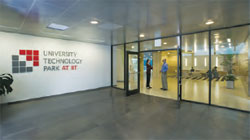
Photo: Bonnie Robinson
Although his office is located within the newer University Technology Park at IIT complex of buildings, Nik Rokop recalls a much earlier IIT when he considers the university’s legacy of entrepreneurship. He says it all began—well, in the beginning— after IIT was founded following a spirited call to action in the “Million Dollar Sermon” of 1890.
“IIT was formed by an entrepreneur, [Philip Danforth] Armour, and I would even say [Frank Wakely] Gunsaulus, who changed careers from preaching at the pulpit to becoming the university’s first president,” says Rokop, managing director of the IIT Stuart School of Business Jules F. Knapp Entrepreneurship Center. “The way the university grew over the years—from the merger of Armour Institute with the Lewis Institute, and, for example, the addition of the School of Design and Chicago-Kent College of Law—is much like how many entrepreneurs work, bringing in smaller entities to build a large one. Many companies go through this kind of growth to later become a fairly substantial enterprise.”
Rokop’s desk is as orderly as are the manila project folders that hold still more organized flowcharts and notes on the many entrepreneurial endeavors taking place at IIT, including one of the newest, the IIT Stuart School of Business Entrepreneurship Academy. Rokop is managing director of the academy, which is under the leadership of Executive Director Harvey Kahalas, IIT Stuart dean.
“The Entrepreneurship Academy is a university-wide initiative designed to advance the spirit and understanding of entrepreneurship across the campus,” says Kahalas, “and to promote innovation and excellence as set forth by IIT’s Many Voices, One Vision strategic plan. As such, one of our priorities will be to build a formal support system to help students, faculty, and alumni innovate new ideas and successfully take their ideas to the marketplace.”
Plans for the academy, which will unfold over a five-year period, include its role as the umbrella organization for all IIT entrepreneurship organizations and activities, including the Knapp Center; the Kern Innovation and Entrepreneurship Academy (KIEA), a competitive academic/scholarship program for engineering undergraduates; the KnappLab, a mobile phone application facility; student clubs, such as the Innovation and Entrepreneurship Academy, the Undergraduate Business Council, and the Stuart Investment Club; and the IIT Angel Network, an executive-level group of alumni and Chicago business leaders who have made funding commitments to five IIT-connected startups in the last 18 months. The academy is also overseeing the establishment of an expanded entrepreneurship minor and coordinating extracurricular experiential learning opportunities, mentorship programs, and competitions, such as the popular iPhone App Challenge Weekend.

intellectual property [left], with Nik Rokop at the KnappLab
The academy will hold some of its activities in the Idea Shop, an expansive physical space designed to foster collaborative idea generation. Located at UTP—home to high-technology startups and established companies, some begun by IIT faculty entrepreneurs [see below sidebar]—the 13,000-square-foot facility provides students with the space and rapid-prototyping equipment to both encourage and assist in a variety of team-based endeavors. Several Interprofessional Projects (IPRO) Program courses have already been held there, and a prototype of the new IPRO 2.0 format was piloted in the Idea Shop with 100 students during the fall semester.
Rokop says that more than 20 courses related to entrepreneurship are currently offered at the undergraduate and graduate levels. This is in addition to the IPRO courses that have an entrepreneurial slant, called EnPROs, where students have the added challenge of developing an idea for market. Some student EnPRO projects have received outside grants or have served as the launching pad for businesses beyond IIT. Most recently, the EnPRO eMotion, which created a safe method of social networking for “tween” girls ages 7-12 with its product, BFF Gemz, became a student-owned company.
Students enrolled in Stuart’s graduate finance program have the opportunity to hear entrepreneurs present their ideas in a course taught by Ron Kirschner, a former medical practitioner and successful entrepreneur who is the founder and president of Heartland Angels, a prominent Midwest angel investor group. John F. O. Bilson, professor of finance and director of Stuart’s finance and mathematical finance programs, says that students learn a broad spectrum of skills that are useful to successful entrepreneurs.
“The students are required to evaluate the proposal based upon such characteristics as ethics, leadership, and creativity, and make a recommendation for funding,” he explains, noting that this course and another entitled Entrepreneurial Finance provide students with both quantitative and qualitative learning experiences. “IIT Stuart firmly believes that the two-course combination provides our students with the correct composite of academic excellence and real-world application that is characteristic of the business programs we offer.”
Faculty Companies Find a Home In UTP

Since 2005, University Technology Park at IIT has provided a haven for startup companies and budding entrepreneurs, especially through its Incubator facility. Because it is part of the university, UTP is able to connect clients with valuable resources at IIT, including services offered through the Knapp Entrepreneurship Center and various types of funding opportunities.
Some clients to call UTP home throughout the years did not begin as external clients but rather were already connected with IIT when they joined the park: university faculty members. Four current and former faculty members have been UTP clients since the park opened. Two professors whose companies are currently located within UTP include Miles Wernick and Phil Troyk.
Wernick’s company, Predictek, Inc., was one of UTP’s first clients. Predictek provides neuroimaging data analysis and consulting services, and has developed two products: the IRis™ ophthalmic imaging system (currently being tested clinically) and pipelineMAX™, a neuroimaging data analysis software package.
“IIT encourages faculty to pursue entrepreneurial activities, and UTP provides a great home for small businesses,” says Wernick, who is Motorola Chair Professor in electrical and computer engineering, and president of Predictek. “Nik Rokop of the Knapp Center is an energetic supporter of small businesses like mine, providing creative ideas and useful contacts.” Wernick notes, for example, that Rokop assisted the Predictek team in how best to structure a complicated business deal.
“We don’t necessarily graduate people who go on to become CEOs of existing Fortune 500 companies; we graduate people who go on to create significant companies.” —Nik Rokop
Troyk, an associate professor of biomedical engineering, and his company, Sigenics, have been at UTP for the past five years. The company designs and supplies custom integrated circuits for sensor, analog, and mixed-signal applications. Their chips are used in medical and non-medical products. For those with upper limb amputation, Sigenics-designed implantable myoelectric muscle sensors may soon help to restore natural control of robotic prosthetic limbs. Since joining UTP, Sigenics has grown from a startup to a small company with 15 employees.
“Sigenics and IIT greatly benefit from our being near the university,” explains Troyk. “All of our engineers are IIT alumni, and some were student interns at Sigenics. UTP provides an environment that helps our growth. Now Sigenics is giving back to IIT through participation in the IPRO Program and joint research projects. The new role of entrepreneurship in higher education is being defined by IIT and UTP. Sigenics is proud to be part of this transformation.”

Another two-course combination, this one offered to first-year engineering students, is demonstrating that entrepreneurship can be taught by igniting the spark known as creativity.
“I don’t need to teach creativity as much as I need to accentuate it and inspire; the students already come to class with creativity,” explains Mark Snyder, Coleman Faculty Fellow and senior lecturer in the Department of Civil, Architectural, and Environmental Engineering, about the strategy he uses in his Professional Practice courses, whose themes are creating the student innovator (fall) and creating the engineer entrepreneur (spring).
In the course, students delve into the inner workings of entrepreneurship—learning what an entrepreneur is and is not, the myths of entrepreneurship, and the importance of ethics in engineering. Snyder also shows them how to take creativity one step further by adding a value component to their projects. In one course exam, Snyder gives student teams $5 each and instructs them to return to class the next week with more than $5. He says that thus far, the largest sum attained has been $360.
Other projects, such as the SEED (Sustainable Entrepreneurship for Economic Development) initiative at Stuart’s Center for Strategic Competitiveness, aim to take the benefits of entrepreneurship beyond the academic setting. SEED explores and actively engages with communities across the United States to retain their small-town characteristics while increasing economic attractiveness and vitality through entrepreneurial development, information ubiquity, dramatic technology, and sustainability. For IIT students and alumni, Rokop envisions that the university’s breadth of entrepreneurial expertise—reaching from classrooms and labs to the outside community—will benefit them from the time they are in high school through their alumni years. By supplementing college exploratory programs such as Discover Business at Stuart and The Academy for Future Leaders in Science and Technology with an agenda of new entrepreneurial activities, he hopes to show prospective students that IIT offers an environment where good ideas can be developed and supported, and transformed into successful businesses.
“We don’t necessarily graduate people who go on to become CEOs of existing Fortune 500 companies; we graduate people who go on to create significant companies,” Rokop says, citing Edward Kaplan (ME ’65), co-founder of Zebra Technologies; Victor Tsao (M.S. CS ’80), founder of Linksys; and John P. Calamos Sr. (BE ’63, M.B.A. ’70), founder of Calamos Asset Management [see sidebar].
Alumni from all class years can benefit from IIT’s entrepreneurial community by interacting with more experienced alumni who are helping to ensure that IIT’s legacy of entrepreneurship continues. In addition to serving in the IIT Angel Network or on the Knapp Board of Advisors, alumni entrepreneurs have provided funding for courses, served as IPRO or EnPRO advisors and judges, and headed competitions featuring new technology. In Snyder’s course, two luncheons connecting students and alumni entrepreneurs have taken place and have proven to be popular with both students and alumni.
“My students have discovered that engineering is a vehicle that allows them to do almost anything that they can imagine,” says Snyder, adding that he could not take credit for what many in his class regarded as being a revelation. “And they learned that from our alumni.”
IIT Alumni
A Legacy of Entrepreneurs
From the founding of the university to the new Entrepreneurship Academy, IIT’s history is filled with entrepreneurial success stories. Here is a small sample of the many IIT alumni whose endeavors have impacted their fields, society, or the spirit of entrepreneurship itself.
Florence Knoll Bassett (ARCH ’41)— co-founder of Knoll, designer and distributor of modern residential and corporate furniture and textiles
John P. Calamos Sr. (BE ’63, M.B.A. ’70)—founder, chairman, chief executive officer, and co-chief investment officer of Calamos Asset Management, Inc.
Hazem Dawani (CPE ’01)—co-founder, president, and chief executive officer of electronic trading platform provider OptionsCity
Brian L. Hoekstra (PHYS ’81)—director and chief executive officer of IA Global, Inc.; founder and former president and chief executive officer of Applied Photonics, Inc.
Edward Kaplan (ME ’65)—president of Nalpak, Inc.; co-founder and chairman emeritus of Zebra Technologies, a manufacturer of thermal bar code label printers and supplies
Terry Ni (M.S. ENVE ’82)—founder of T N & Associates, acquired by Oneida Total Integrated Enterprises, which offers government clients environmental and other services
Robert A. Pritzker (IE ’46)—president and chief executive officer of Colson Associates, Inc.; founder of The Marmon Group, an international association of autonomous manufacturing and service companies
Ron Rashkow (BE ’64)—founder, chairman, and chief executive officer of the Handy Andy chain of home improvement centers
Ellen Jordan Reidy (PSYC ’79, M.B.A. ’81)—founder and president of America’s Food Technologies, Inc., a blending and packaging operation specializing in custom and private label beverages
Victor Tsao (M.S. CS ’80)—founder and chairman of Miven Venture Partners; founder of Linksys home wireless-networking company (sold to Cisco)
More Online
Jules F. Knapp Entrepreneurship Center: knappcenter.iit.edu
KnappLab: www.knapplab.com
Interprofessional Projects (IPRO) Program: ipro.iit.edu